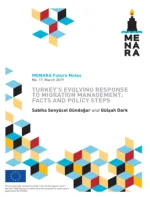Turkey’s Evolving Response to Migration Management: Facts and Policy Steps

MENARA Future Notes nº. 17
Data from the United Nations Refugee Agency (UNHCR) show that there has been a significant increase in the number of forcibly displaced people worldwide in the last decade, with the number of people in asylum or with refugee status rising from 42.7 million in 2007 to 68.5 million by the end of 2017 (UNHCR 2018: 4). There are a number of underlying causes of this substantial increase. First is the conflict in Syria since 2011. The dramatic escalation of that war and the accompanying human suffering have forced Syrians to leave their homeland and become refugees, generating the worst refugee crisis since the Second World War. However, the Syrian conflict is not the only cause; turmoil in other Middle East and North Africa (MENA) countries has resulted in the displacement of considerable numbers of people. According to UNHCR data (Table 1), more than 68 per cent of refugees worldwide come from the following five countries: Syria, Afghanistan, South Sudan, Myanmar and Somalia.